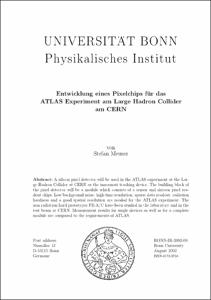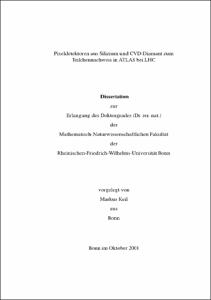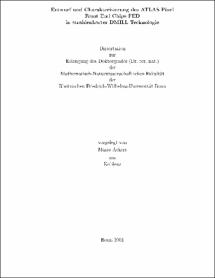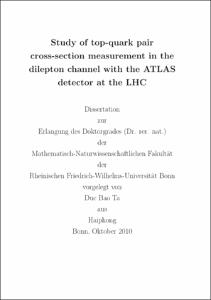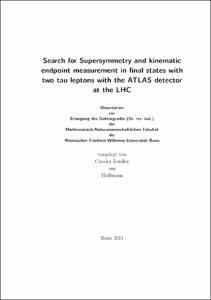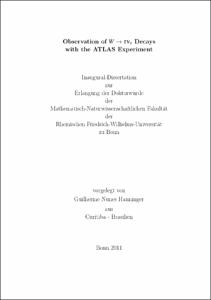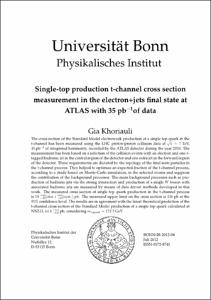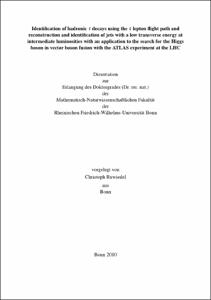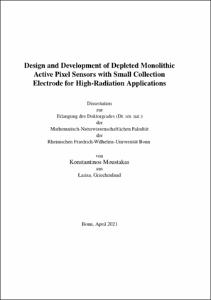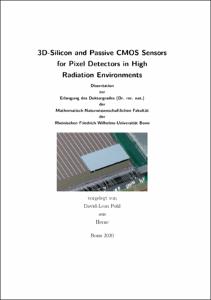Mathematisch-Naturwissenschaftliche Fakultät: Suche
Anzeige der Dokumente 1-10 von 30
Entwicklung eines Pixelchips für das ATLAS Experiment am Large Hadron Collider am CERN
(2002)
A silicon pixel detector will be used in the ATLAS experiment at the Large Hadron Collider at CERN as the innermost tracking device. The building block of the pixel detector will be a module which consists of a sensor and ...
Pixeldetektoren aus Silizium und CVD-Diamant zum Teilchennachweis in ATLAS bei LHC
(2001)
The ATLAS experiment at the future Large Hadron Collider at CERN uses a silicon pixel detector as the innermost tracking device. Measurements characterising the prototype ATLAS pixel readout chip FE-A/C are described and ...
Entwurf und Charakterisierung des ATLAS Pixel Front End Chips FED in strahlenharter DMILL Technologie
(2001)
Der Entwurf und die Charakterisierung des Auslesechips FED für den ATLAS Pixeldetektor in der strahlenharten DMILL Technologie werden in dieser Arbeit beschrieben. Bei einer Ereignisrate von 40 MHz und einer totalen ...
Study of top-quark pair cross-section measurement in the dilepton channel with the ATLAS detector at the LHC
(2011-09-16)
The top quark is the heaviest of the known fundamental particles in the Standard Model (SM) with a mass of 173.3±1.1GeV. It is the sixth quark in the SM and the weak isospin partner of the bottom quark. Properties such as ......
Search for Supersymmetry and kinematic endpoint measurement in final states with two tau leptons with the ATLAS detector at the LHC
(2011-10-21)
Discovery prospects for Supersymmetry in final states with at least two tau leptons and large missing transverse energy are evaluated for LHC proton-proton collisions measured with the ATLAS detector. In a first study based ......
Das Entdeckungspotential von Supersymmetrie mit Endzust¨anden aus mindesten zwei Tau Leptonen und fehlender Transversalenergie in Proton-Proton Kollisionen wird untersucht, sowie die M¨oglichkeit einer Messung des Endpunktes ......
Das Entdeckungspotential von Supersymmetrie mit Endzust¨anden aus mindesten zwei Tau Leptonen und fehlender Transversalenergie in Proton-Proton Kollisionen wird untersucht, sowie die M¨oglichkeit einer Messung des Endpunktes ......
Observation of W → τντ Decays with the ATLAS Experiment
(2011-05-04)
Physics studies of processes with t leptons in the final state, while challenging at hadron colliders, are of great importance at the LHC. The τ leptons provide important signatures in searches for the Higgs boson as well ......
Single-top production t-channel cross section measurement in the electron+jets final state at ATLAS with 35 pb-1 of data
(2012-09-03)
The cross section of the Standard Model electroweak production of a single top quark in the t-channel has been measured using the LHC proton-proton collision data at $sqrt{s}=7$ TeV, $35 {\rm pb}^{-1}$ of integrated ...
Identification of hadronic τ decays using the τ lepton flight path and reconstruction and identification of jets with a low transverse energy at intermediate luminosities with an application to the search for the Higgs boson in vector boson fusion with the ATLAS experiment at the LHC
(2010-07-01)
Three studies of different components of the object reconstruction with the ATLAS experiment using simulated data are presented. In each study, a method for the improvement of the reconstruction is developed and the ...
Design and Development of Depleted Monolithic Active Pixel Sensors with Small Collection Electrode for High-Radiation Applications
(2021-09-27)
Depleted monolithic active pixel sensors (DMAPS) have emerged as a low material and low cost alternative to the established hybrid technology. In this thesis, two large scale prototype chips that feature a fast column-drain ...
3D-Silicon and Passive CMOS Sensors for Pixel Detectors in High Radiation Environments
(2020-10-30)
The future upgrade of the Large Hadron Collider to the High-Luminosity LHC demands new pixel detectors that can operate in environments with exceptionally high radiation. This requires investigations into new radiation-tolerant ...


